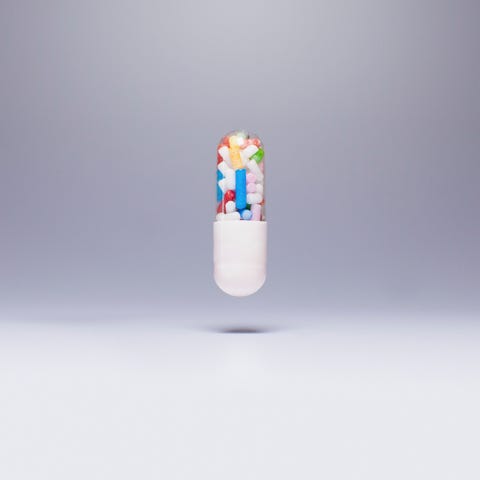
You’re familiar with the fad diet cycle: Today’s keto diet is yesterday’s Atkins.
There’s a near-constant rotation of weight loss plans that promise to supercharge your metabolism, tap energy stores, and ignite your fat burners—all in the name of a thinner, leaner you.
The GOLO diet is an exception only to the fad diet churn-and-burn cycle in that it builds itself around an expensive supplement. That pill, called Release, isn’t FDA approved. The research GOLO uses to tout the power of Release isn’t, well, all that powerful.
And there’s more to it.
What, exactly, is the GOLO diet?

Jose Luis Pelaez Inc
The GOLO diet suggests that spiked insulin levels are the cause of slow metabolism, which, in turn, is responsible for weight gain. GOLO argues that when you can control your insulin levels, you won’t store excess sugar in your blood, which your body then stores as fat. Regulated insulin levels equal regulated weight.
The company makes this claim based on a team of doctors and pharmacists, though the company does not disclose the names and affiliations of these experts.
To its credit, the GOLO diet, unlike Whole30 or keto, does not prohibit or severely restrict you from eating entire food groups.
Instead, the GOLO diet focuses on whole, unprocessed, and unrefined foods. At mealtime, a dieter selects one to two servings from each category—proteins, carbs, vegetables, and fats.

AJ_Watt
A GOLO dieter eats three meals a day, with breakfast and lunch meals larger than dinner. The diet permits snacks if you go longer than four to five hours between meals or if you exercise.
While this type of eating plan can work, this is where the GOLO diet starts to veer into questionable territory.
Supplement territory.
So what about this supplement, Release?

Ralf Hiemisch
One of the core components of the GOLO diet is a supplement called Release. The company claims that Release will help kickstart your body’s ability to regulate insulin, increase your metabolism, and burn more fat.
Here’s what’s in Release: magnesium (15 milligrams in 1 capsule), zinc (10 mg), chromium (70 micrograms)*, rhodiola root extract, inositol, berberine HCl, gardenia, banaba leaf extract, salacia bark extract, apple extract, vegetable cellulose, dextrin, glycine, silica, citric acid
*These three ingredients are the only three ingredients with amounts listed on the label. The amounts of these ingredients, however, are not disclosed because the formulation is patented.
And then there’s the price.
One bottle (containing 90 capsules) costs $50. Buy three bottles and you’ll reduce that fee to $99, but you can’t shop around for Release anywhere cheaper because you can only buy the supplement through the company.
Does the GOLO diet and Release actually work?

fotostorm
Approach with caution, says Abby Langer, R.D., founder of Abby Langer Nutrition.
First, there’s the idea that eating certain foods can drastically improve your metabolic rate.
“There’s nothing you can really eat to boost your metabolism to any degree that you will have a significant change in weight,” Langer says. “Your metabolism is dictated by genetics and muscle mass and, sure, hormones. But there are so many factors that something you eat won’t radically change it.”
Theories do exist linking increased insulin and weight gain, but scientists still aren’t certain which hormones control metabolism and weight.

Eva-Katalin
“It’s a theory for a reason. It hasn’t been studied a lot in humans,” she says. “We really don’t know definitively if insulin resistance is responsible for increased body mass.”
The GOLO diet centers on whole foods, and doesn’t require you to eliminate food groups, which is a smart way to eat—but you don’t need the GOLO diet to eat this way.
And you surely don’t need a supplement, says Langer.
“Release is just a supplement. While it may not be harmful physically, I don’t recommend it,” she says.
But what about GOLO’s success stories and research?

Maskot
GOLO dieters have reportedly lost upwards of 100 pounds in just 12 months, and that can carry undeniable allure for someone looking to lose weight.
Except that that weight loss may have occurred not from GOLO’s proclaimed ability to help regulate insulin, but instead from switching from processed foods to whole foods.
While GOLO leans heavily on the theory that insulin resistance slows metabolism, Langer cautions that there is no simple or accurate way to definitively measure a person’s metabolism. As a result, there is no way to measure the GOLO diet’s success.
“This is the hallmark of a fad diet,” Langer says. “You give the followers an outcome that they can’t measure.”
And the research cited by the company?
“The research studies done to support GOLO’s claims were small,” she says. “The studies were done by the company. None of their stuff has been published in peer reviewed journals.”
Rather than following one of these one-size-fits-all diets, Langer says the best path to an effective diet is to talk to a registered dietitian and carve out a plan tailored to you life, your goals, and your eating habits.
And consider this, as it pertains to all diets: If there was one diet on which everyone would lose weight and keep that weight off forever—wouldn’t everyone already be on that diet?
Source: Read Full Article